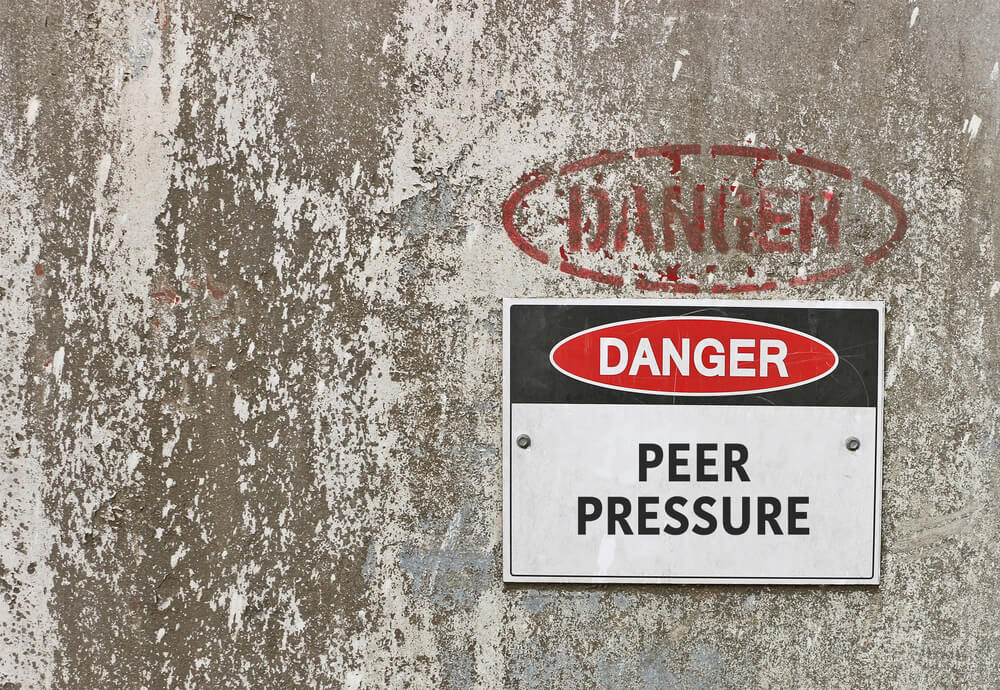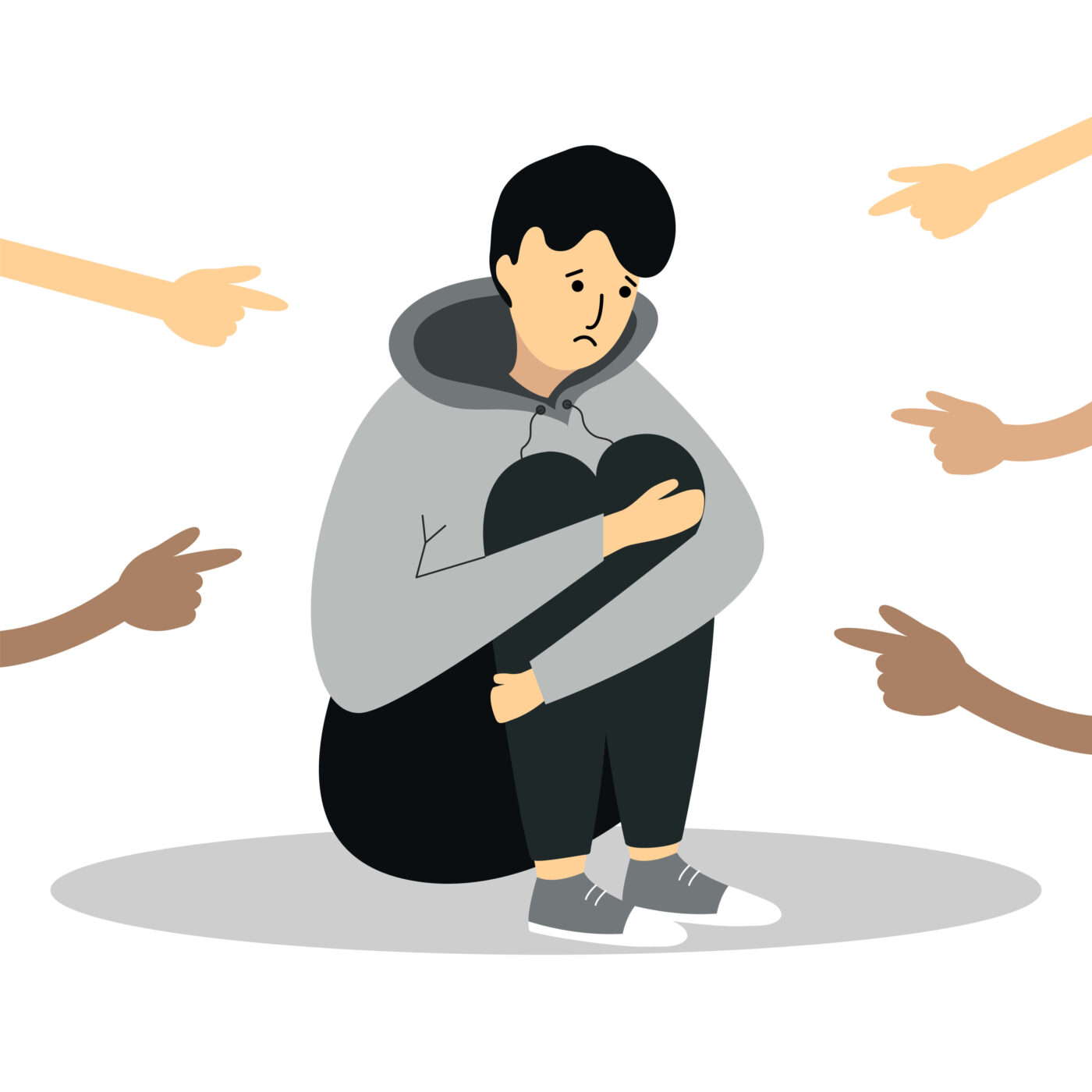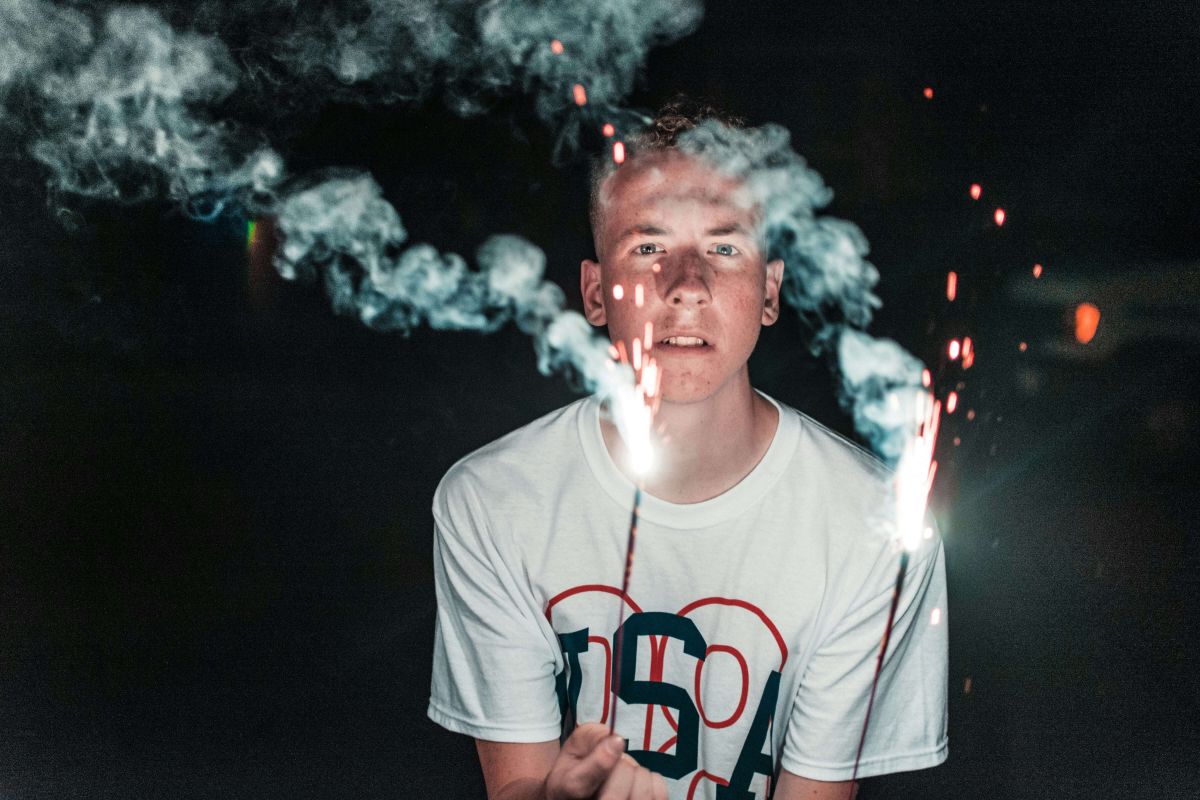
Kimberly couldn’t believe what she was seeing. The giant purple + on the test stick would change her life forever. Her boyfriend, Mark, was going to freak out. She couldn’t be pregnant! They only had sex a couple of times – and her friends were so excited for her to be taking that big step in her relationship.
When Mark found out, he did freak. He became angry and aggressive with Kimberly, calling her a slut and denying that the baby was his. His rap career in LA hadn’t taken off yet, and he couldn’t support a baby. He stomped off in anger – he needed to be with his boys and get wasted. Drunk or high, Mark didn’t care – he just wanted the support of his friends and peers.
The story of Kimberly and Mark is far too common among teens all over the country. Peer pressure convinces them to take certain actions, and when they do, they suffer the natural consequences – which they are not mature enough to handle. Peer pressure can lead students to alcohol, drugs, unsafe sex practices, blatant disrespect for authority, and aggression toward family members.
Alcohol
It is extremely difficult to get kids to understand the dangers of drugs and alcohol unless they witness a tragic event first-hand. If their parents drink safely, and in moderation, they may think it’s okay for them to drink, but rarely do they do it safely or in moderation.
Because the reasoning centers of their brains are not yet fully developed, teens cannot make a proper choice about whether or not to drink – especially when under peer pressure.
Though the brain may reach its largest size during adolescence, it continues to develop and mature well into the mid- to late 20s. “The front part of the brain, called the prefrontal cortex, is one of the last brain regions to mature. This area is responsible for skills like planning, prioritizing, and controlling impulses. Because these skills are still developing, teens are more likely to engage in risky behaviors without considering the potential results of their decisions.”
In fact, according to the Centers for Disease Control (CDC), the statistics on teen drinking are alarming, including that alcohol is the most commonly abused drug among teens, excessive drinking is responsible for more than 3,200 deaths among youth each year, while the purchase of alcohol by teens under 21 is illegal, people aged 12 to 20 years drink 11% of all alcohol in the United States, teen drinkers have more drinks per party than adult drinkers, and in 2013, there were nearly 119,000 emergency room visits by youth aged 12 to 21 for alcohol related conditions or injuries.
Peer pressure can be one person pressuring another, like offering someone a drink or encouraging drinking. This usually occurs in social situations like parties. Peers may refill a fellow teen’s cup without asking permission or a peer may give you a hard time if you are not drinking. Saying no may make a teen feel like an outcast. Peer pressure is at its worst when other teens ostracize and socially isolate the teen who decides not to drink.
When underage drinking gets out of hand, teens end up in the hospital, may drive drunk, or could even kill themselves or others – for no other reason than to be considered “cool” or be part of the “in crowd”. Getting caught drinking has legal, social, academic, and family consequences. Many students have lost scholarships to college, been given community service or jail time, or been singled out in the family as the troublemaker.
Teen drinking is a prevalent problem in our society caused by peer pressure, but so is drug abuse.
Drugs
With the recent legalization of marijuana in several states, the use of pot will no doubt increase – even if state legislators create a minimum age purchase at 18. There are hundreds of thousands of 18 year old kids still in high school. And the legalization of the drug gives teens the sense that it is safe to use. They sometimes forget that just because something is legal doesn’t mean it’s good for you.
Peer pressure can influence teens’ choices about drug use. New research shows that, teens making decisions think about the risks and rewards of their and behaviors—but, teens are far more likely to ignore the risk to get the reward. A recent study showed that just knowing one’s friends are watching activated the brain areas linked with reward, especially when making risky decisions.
Biochemically, the desire to impress friends will override the fear of risks. You can be influenced by who’s around and if you want to impress them.
If someone is suffering from the physiological effects of alcohol or other drug use, he has likely continued despite academic difficulties, relationship difficulties, and other health and social consequences.
The long-term effects of alcohol, tobacco, and drug misuse include the following:
- liver damage and heart problems
- a visible “beer belly” from too much drinking
- physical dependence on alcohol
- cancer and/or emphysema
- reduced lung capacity
- blackened or yellowed teeth
- early wrinkle formation
- impaired problem solving
- arrested emotional development
- memory problems
- disruptive, chronic, and persistent lack of motivation
- increased risk of mental health disorders other than addiction
- mood disorders (e.g., major depressive disorder)
- anxiety disorders (e.g., generalized anxiety disorder)
- psychotic disorders (e.g., schizophrenia)
“Given the teen brain’s unique vulnerability to substance use and addiction, it is extremely important that teens learn about the immediate, short-term, and long-term consequences of any substance use.”
A further consequence of alcohol and drug use is the participation in unsafe sex.
Unsafe Sex
As we said earlier, a teenage brain is not fully matured or developed, causing deficiencies in decision-making processes. If you had drugs or alcohol, or intense peer pressure, the decisions made will be far more risky than if made with a mature, sensible thought process.
According to WebMD, risky sexual practices are more common among teens than most parents would like to believe. Fewer than 1% of youth questioned had their first sexual experience at age 11, 2.5% reported their first sexual intercourse at age 12, 6.7% at 13 years old, about 13% reported having sexual intercourse for the first time at age 14, about 16% at age 15, about 20% at age 16, 12% at age18, and 5% at age 19.
Do these stats mean that “most teens” will have sex before reaching 18 years of age? Not necessarily, but peer pressure will make a difference when it comes to whether or not teens decide to have sex without protection.
According to a study by the Kaiser Family Foundation, the numbers are staggering. Although many teens feel that waiting for sex within marriage is a nice idea, they believe that hardly anyone does it. “In fact, many teens — particularly boys — feel pressure to have sex, and they say drugs and alcohol usually lead to sex — often without condoms.”
For Kimberly and Mark, this was the case. Mark’s “boys” gave him a lot of flack for being a virgin and telling him he wasn’t a man yet. Kimberly’s friends pressured her because she and Mark had been dating for 3 weeks and that was long enough to know if you wanted to have sex. This example demonstrates the immaturity and poor decision making that can happen with teens.
A teen survey by the Kaiser Family Foundation gives a comprehensive picture of youth attitudes and spotlights areas of concern:
- One in six teens say having sex without a condom occasionally is no big deal
- One in five say they have had unprotected sex after drinking or using drugs
- Four in ten sexually active teenagers have taken a pregnancy test or had a partner who did
- More than half of 15-to-17-year-olds say they have had a sexual encounter
- Of teens that have abstained, nearly a third say they have been “intimate”
Because society is so focused on normalizing sex among teens, teens are more prone to participate in risky behaviors involving sex. Many students don’t realize that the peer pressure they succumb to could and may lead to sexually transmitted infections (STIs), unwanted pregnancies, or even partner rape.
Peer pressure revolving around sex is often combined with blatant displays of disrespect for authority as those in authority are the ones telling them not to have sex.
Disrespect for Authority
It is not uncommon for teens to have their “rebellious” phase. However, the past decade has seen an increase in disrespect for authority from teens. The lack of respect for authority is obvious in today’s teenagers. A lack of respect for authority can be crossed arms, rolled eyes, hair flipping, rude gestures, shouting, name calling, and slamming doors. You can ask a simple question, yet the response is disrespectful and rude.
To make things even worse, the media portrays disrespectful teenagers as cool. Those who have seen MTV’s “My Super Sweet Sixteen” will understand this. The show features girls who “feel entitled and in control put together a lavish birthday party paid for by their parents, who in most cases have very little authority over their own daughter.” These teen displays of disrespect and indifference toward others get rewarded rather than punished. Teen girls by the millions idolize these entitled teens and long to be like them – to be indulged without limits and behave outrageously without consequences.
Many parents want to indulge their kids’ demands – something that teen peer pressure uses as a measuring stick to determine one’s “street cred”. Raising a respectful child doesn’t mean you have to give them their own way. Neither does it mean that he or she has to see and do everything your way. Respect is “a courteous consideration of another person.” Respect is separate from decisions, rules, or actions. It’s how you treat the other person when you make decisions, enforce your rules, and stick to your guns.
Peer pressure to get parents to knuckle under to a teen’s demands is high. Teens are finding their independence and want to appear as if they are in control of their entire life – that not even their parents can stop them. And the educational and legal environment has successfully made it nearly impossible for parents to punish their children. There is more concern for the teen’s self-esteem than their need to learn about natural and societal consequences.
When the peer pressure to display disrespect gets out of control, it can lead to far worse problems in the family dynamic, including aggressive behavior towards parents and siblings.
Aggression to Family Members
Along with the disrespect for authority that can be bred from peer pressure, teens may become very aggressive with family members in an effort to earn status among their peers. For example, if your son’s friends all have younger brothers they terrorize, your son may feel the need to terrorize a younger sibling just to fit in with the crowd.
Recent studies of youth aggression have shown there is a connection between peer pressure and aggressive behaviors. Scholars have suggested that teen aggression is motivated by status concerns. However, adolescents don’t necessarily have to share the status motivations of their peer group to have their behavior influenced by peer pressure. Seeking higher social status within friendship groups can oftentimes be dependent on a teen’s willingness to engage in aggressive behavior. “The insight that status motivations—of self and others—can strongly influence aggression may extend to other behaviors in which peers are implicated.”
So, your teen may not be showing aggression at home – but his or her aggression at school can negatively affect relationships within the family. Teens who act aggressively under peer pressure can get into fights, engage in criminal behaviors, or even seriously injure a fellow classmate. When these become intolerable, a teen may be suspended or expelled from school, which leaves only the family available for taking aggression out on, in addition to the social embarrassment the family experiences due to the teen’s behavior.
Teens may also fall victim to peer aggression where they become the victim who needs to lash out. Teens who experience peer victimization are far more likely to act out aggressively both in school and in the family. But when parents act in the teen’s best interest by showing up, being around, engaging with their kids, and being aware of their teen’s activities, otherwise known as “risk buffering”, the teen is less likely to fold under peer pressure. “According to the risk-buffering model, a favorable family context such as parental knowledge can diminish the relation between environmental risk factors like peer victimization and problem behaviors such as aggression.”

Conclusion
Teen peer pressure is not an issue that should ever be taken lightly. The social pressures put on teens to engage in risky behaviors is very real and can result in negative, even life-altering consequences. Talk to your teens about peer pressure and let them know they don’t have to fall prey to the wishes and desires of others.




